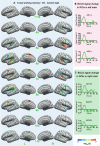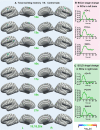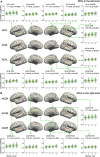The bottom-up information transfer process and top-down attention control underlying tonal working memory
- PMID: 35979330
- PMCID: PMC9376259
- DOI: 10.3389/fnins.2022.935120
The bottom-up information transfer process and top-down attention control underlying tonal working memory
Abstract
Tonal working memory has been less investigated by neuropsychological and neuroimaging studies and even less in terms of tonal working memory load. In this study, we analyzed the dynamic cortical processing process of tonal working memory with an original surface-space-based multivariate pattern analysis (sf-MVPA) method and found that this process constituted a bottom-up information transfer process. Then, the local cortical activity pattern, local cortical response strength, and cortical functional connectivity under different tonal working memory loads were investigated. No brain area's local activity pattern or response strength was significantly different under different memory loads. Meanwhile, the interactions between the auditory cortex (AC) and an attention control network were linearly correlated with the memory load. This finding shows that the neural mechanism underlying the tonal working memory load does not arise from changes in local activity patterns or changes in the local response strength, but from top-down attention control. Our results indicate that the implementation of tonal working memory is based on the cooperation of the bottom-up information transfer process and top-down attention control.
Keywords: attention; cortical activation pattern; functional connectivity; sf-MVPA; tonal working memory load.
Copyright © 2022 Li, Gong, Zhang, Zhang and Liu.
Conflict of interest statement
The authors declare that the research was conducted in the absence of any commercial or financial relationships that could be construed as a potential conflict of interest.
Figures







References
-
- Allwein E. L., Schapire R. E., Singer Y. (2000). Reducing multiclass to binary: a unifying approach for margin classifiers. J. Mach. Learn. Res. 1 113–141.
-
- Baddeley A. (1986). Working Memory. Oxford: Clarendon Press/Oxford University Press.
LinkOut - more resources
Full Text Sources

